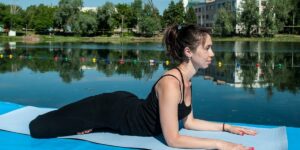Contents
Lower Back Pain
 Lower back pain is a common health problem that is caused by many things. When people are not active, it can cause them to have pain. One symptom of this condition is that they will have pain in their abdomen. This could be because of kidney stones or acute pancreatitis. But sometimes there is no reason for the pain. Stretching is not a cure for all back pain. But it can help if you have been living with some mild discomfort or stiffness. Some back pain exercises and stretches will help your back feel better and stronger.
Lower back pain is a common health problem that is caused by many things. When people are not active, it can cause them to have pain. One symptom of this condition is that they will have pain in their abdomen. This could be because of kidney stones or acute pancreatitis. But sometimes there is no reason for the pain. Stretching is not a cure for all back pain. But it can help if you have been living with some mild discomfort or stiffness. Some back pain exercises and stretches will help your back feel better and stronger.
How To Do Back Pain Exercises?
While doing back pain exercises, stretch your lower back with care and safety. Be especially careful and gentle if you have any type of injury or health concern. It is best to talk to your doctor first before starting any new types of exercise. You can stretch once or twice a day. But if the pain gets worse, or you feel very sore, then take a break from stretching. You should be aware of your body’s limits. Don’t do too much. Listen to what your body wants and do it. Take your time and pay attention to your breathing as you do these exercises. Make sure you don’t strain or overdo it by using your breath as a guide. You should be able to breathe easily and freely throughout each posture or stretch.
Back Pain Exercises
The back is a complex and delicate structure of the human body. So it’s no surprise that back pain can be incredibly difficult to manage. The back provides support for the spine and pelvis as well as housing many important nerves, blood vessels, muscles, ligaments, and discs. When these structures are damaged or become irritated due to an injury or illness such as arthritis or sciatica then back pain can occur. In this blog post, we’ll explore some simple back pain exercises that may help manage some of your back pain symptoms.
1. Child’s Pose

The gluteus maximus, thigh muscles, and spinal extensors are gently stretched in the seated forward bend (Paschimottanasana). It helps to alleviate pain and tightness throughout your spine, neck, and shoulders. And it is one of the best back pain exercises for managing pain.
Furthermore, massages are good for the body. Also, it helps muscles that are tight, which over time can cause problems with flexibility and blood circulation.
To do Child’s Pose, you need to do these steps:
- Furthermore, this means that you will kneel down with your hands on the ground. You have to put your knees on the floor too. Then you have to rest your hips on your heels.
- Fold forward at your hips as you walk your hands out in front of yourself.
- Lie down on your side and put your weight on one of your thighs.
- Put your arms in front of or next to you and put your palms up.
- Focus on breathing in and out. Do this to relax your body.
- Hold this pose for 1 minute.
You can do this pose, um, how many times? Also, you can do it to break up your stretches. You can also do it between each stretch you are doing.
Modifications
Also, put a rolled-up towel on top of or beneath your thighs if you feel like you need extra assistance. If it’s more pleasant, widen your knees and rest your forehead on a cushion.
2. Knee-to-chest Stretch
 This is one of the back pain exercises that stretch relaxes your hips, thighs, and glutes while promoting overall relaxation. To do a knee-to-chest stretch:
This is one of the back pain exercises that stretch relaxes your hips, thighs, and glutes while promoting overall relaxation. To do a knee-to-chest stretch:
- Lie on your back with both knees bent. Put your feet flat on the floor.
- Hold your left knee bent or extend it out to the floor.
- Bend your right leg and bring it close to you. Put your hands behind the top of your leg or around the top of your shin.
- Do not raise your butt and lower your back.
- Breathe. Release any tension.
- This exercise will help you. You hold this pose for 30 seconds to 1 minute.
- Repeat the exercise with the other leg.
Modifications
Moreover, you can put a pillow under your head for more padding. If you cannot reach your leg, wrap a towel around it and pull up on the towel with both arms. Of course, to deepen the stretch, tuck your chin into your chest and lift your head up toward your knee.
3. Piriformis Stretch

This stretch will work a muscle deep in your butt. If you stretch it, you can get pain and tightness in your butt and lower back to go away.
To do a piriformis stretch, you need to follow these steps:
- Lie on your back. Bend both of your knees. Put your feet flat on the floor.
- Put your right ankle at the base of your left thigh.
- Stretch your arms up to feel the stretch.
- Hold this position for a minute.
- Then do the other side.
Modifications
In order to make the stretch more comfortable, keep your bottom foot on the floor and rest your head on a cushion.
4. Seated Spinal Twist

Furthermore, a classic twist, popular for many years, stretches your hips, glutes, and back. Also, it improves spinal mobility and abdominal, shoulder, and neck flexibility. The strain of this stretch activates your internal organs as well.
To do a seated spinal twist, follow these steps.
- Sit on the floor with both of your legs out in front.
- Bend your left leg and put your foot on the outside of your right thigh.
- Put your right arm on the outside of your left leg.
- Put your left hand behind you for support.
- Starting from the base of your spine, twist to the left side.
- Hold this pose for up to 1 minute.
- On the other side, repeat.
Modifications
To make this pose more comfortable, keep both legs straight. Similarly, you can do neck rotations during this pose by inhaling to look forward and exhaling to turn your gaze backward. Do 5 to 10 on each side.
5. Pelvic tilt

When you perform pelvic tilts, your abdominal muscles get stronger, which relieves lower-back discomfort and tightness. They also have a beneficial impact on your glutes and hamstrings.
To do a pelvic tilt, follow these steps:
- Lie down on your back with both of your knees bent and feet touching the floor.
- Likewise, engage your abdominal muscles to flatten your back.
- Please breathe normally, while holding this position for 10 seconds.
- When you are nervous, take a few deep breaths. It will help to relax.
- Do 3 sets of 5 repetitions.
6. Cat-Cow

Cat-Cow is a way to make your spine wake up. Also, you can also stretch your shoulders, neck, and chest. To do Cat-Cow, you need to follow these steps:
- Get on the ground in a table-top position.
- Press your hands and feet into the ground as you breathe in. This will make you look up, which will allow your belly to fill with air.
- Exhale, tucking your chin to your chest and arching your back.
- Move with each breath.
- Do this for 1 to 2 minutes.
Modifications
Place your hands slightly in front of your shoulders instead of directly beneath them if you have wrist problems. For this purpose, place a cushion under your knees for additional comfort and support if you have any knee concerns.
For stronger grips, attempt holding each posture for 5 to 20 seconds at a time rather than moving with each breath.
7. Sphinx stretch

Sometimes, the sphinx stretch is a good backbend. It helps you to be both active and relaxed. Also, this stretch helps your spine, buttocks, and chest too.
To do the sphinx stretch, follow these steps:
- Lie on your stomach with your elbows underneath your shoulders. Your hands should be forward with the palms of the hand down.
- Step your feet apart. Your toes can touch.
- Keep your back, buttocks, and thighs straight as you lift your head and chest.
- Stay strong in your lower back and abdominals. Breathe deeply.
- Press your lower body into the ground.
- Place your eyes in the front of your head. Look straight ahead or close your eyes.
- Hold this pose for 30 seconds to 1 minute.
8. Bridges

For this purpose, squats and bridges target the gluteus maximus, which is the big muscle of the buttocks. When people move their hips, this muscle is activated, particularly when they bend down. The gluteus maximus is one of the body’s most important muscles, and maintaining it strong can aid back support.
To do a bridge:
- Lie down on the floor and put your knees on it. Put your feet flat on the ground and make sure they are about hip-width apart.
- Stand up straight with your feet on the ground.
- To do the sit-up correctly, you need to raise your butt off the ground. Then your whole body will be in a straight line from your shoulders to your knees.
- When you’re on the floor, spread your legs apart. Then bend your knees and put both hands on your butt. Push one hand to the other until they are together again.
- Lower your butt to the ground and rest for a few seconds.
- Do this 15 times and then rest for 1 minute.
- Do 3 sets of 15 reps.
9. Lower back rotational stretches

Sometimes, the lower back rotational stretch can help relieve lower-back and trunk tension. It also gently exercises the core muscles to improve posture. To do the lower back rotational stretch, follow these steps:
- Lie on the floor with your knees bent and feet on the ground.
- Put your shoulders on the floor and roll both of your knees to one side.
- Hold the position for 5 seconds.
- Go back to the position you started with.
- Roll the knees gently to the other side. Hold for a moment, and then move back to the starting position.
- You should do 2–3 rounds of this exercise on each side a total of 4 times every day.
Conclusion
To sum it up, back pain is an incredibly common problem that affects a lot of people. It can be difficult to manage, but there are many ways you can help prevent it from happening or at least make the symptoms less intense. Additionally, regular back pain exercises and good posture will go a long way towards helping your back stay healthy. If you find yourself experiencing any unusual discomfort in your lower back, don’t hesitate to contact us for a consultation today.
Physical Therapy help patients recover from pain. If you’re experiencing Back pain, Shoulder pain, Knee pain, Neck pain, Elbow pain, Hip pain or Arthritis pain, physical therapist at MantraCare can help: Book a physio therapy session.


